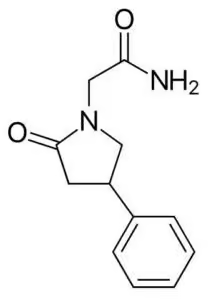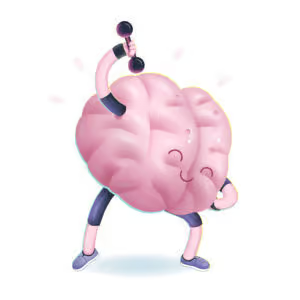Table of Contents
Key Takeaways
- Phenylpiracetam is a powerful water-soluble nootropic that enhances cognition, memory, focus, learning, and physical stamina, with a stimulant effect.
- It is 20 to 60 times more potent than Piracetam due to the addition of a phenyl group, which increases its bioavailability and ability to cross the blood-brain barrier.
- Phenylpiracetam is banned in professional sports due to its performance-enhancing properties, including improved athletic performance and resistance to cold.
- It has clinical applications as a treatment for epilepsy and is used as a prescription drug in Russia and Eastern European countries.
- Phenylpiracetam dosage recommendation is 100 mg 2-times per day.
Phenylpiracetam ((R,S)-2-(2-oxo-4-phenylpyrrolidin-1-yl) acetamide, Phenotropil, Fenotropil, Carphedon, Fonturacetam) is a water-soluble nootropic in the racetam-class of compounds.
Phenylpiracetam was created by adding a phenyl group to Piracetam by Russian scientists in 1983. It was developed as a nootropic to boost cognition, and to improve physical stamina.
It turns out that Phenylpiracetam is very effective in boosting athletic performance. It provides significant stimulatory effects and helps you resist cold. Leading to a ban by the World Anti-Doping Agency from use by athletes in the Olympics and other professional sports.[i]
Russian cyclist Anton Reshetnikov was suspended in 2007 for 2 years from the International Cycling Union for using Carphedon.[ii] One year earlier (2006), Russian Olympic athlete Olga Pyleleva lost her silver metal for using Carphedon.[iii]
Carphedon is a brand name for Phenylpiracetam. Adding a phenyl group to Piracetam boosts the bioavailability of Phenylpiracetam. It easily crosses the blood-brain barrier and is considered 20 to 60-times more potent than Piracetam.[iv]
Neurohackers report that Phenylpiracetam enhances alertness, focus, memory, and learning. It reduces brain fog. And it improves physical stamina and cold tolerance while combating physical and mental fatigue.
Phenylpiracetam helps:
- Prevent Anxiety & Fear: Phenylpiracetam helps reduce symptoms of anxiety and fear. Unlike popular prescription anti-anxiety and anti-depressant drugs, Phenylpiracetam has no sedative action or other adverse side effects associated with these medications.[v]
- Neuroreceptors: Phenylpiracetam increases the density of acetylcholine (ACh), NMDA, GABA and dopamine receptors in the brain.[vi][vii]More receptors mean more binding sites for neurotransmitters that affect memory formation, cognition, sleep and mood.
- Cerebral Circulation: Phenylpiracetam increases blood flow in the brain. As a derivative of Piracetam, this nootropic has the same mechanism of action when it comes to blood flow. It suppresses the constriction of blood vessels allowing the freer flow of blood. More oxygen and nutrients get to brain cells boosting alertness, cognition, focus and mood.[viii]
Overview
Phenylpiracetam (((R,S)-2-(2-oxo-4-phenylpyrrolidin-1-yl) acetamide) was created by adding a phenyl group to the original nootropic Piracetam.

Russian chemists synthesized Phenylpiracetam in 1983 to boost the physical and mental performance of astronauts during space flight. It’s currently used by Russian cosmonauts on the International Space Station.[ix]
Phenylpiracetam combats physical and mental fatigue. It enhances memory, mood and focus. It facilitates learning and retention, reduces brain fog, increases alertness and boosts physical stamina and tolerance to cold.
Phenylpiracetam is also an effective treatment for epilepsy. This debilitating condition is caused by sudden surges of electrical activity in the brain. This temporary disturbance in messaging systems between brain cells can cause a seizure. Normal brain function gets halted or mixed up. This is where Phenylpiracetam comes in.
Phenylpiracetam has been shown in animal studies to affect Alpha and Beta brain waves.[x] Scientists haven’t quite figured out why it works, but Phenylpiracetam has an ‘anti-convulsive’ action in the brain. They did conclude after one clinical trial, “Phenotropil reduced the frequency of seizures and improved cognitive function in the absence of epileptiform EEG abnormalities.”[xi]
Phenylpiracetam is sold as a prescription drug in Russia and several Eastern European countries. In the United States, Phenylpiracetam is sold as an unregulated OTC research compound.
How does Phenylpiracetam work in the Brain?
Phenylpiracetam boosts brain health and function in several ways. But two in particular stand out.
- Phenylpiracetam as a stimulant. Phenylpiracetam increases the density of neuroreceptors. Studies have shown it increases the density of acetylcholine (ACh), dopamine, GABA, and NMDA receptors. This translates into more receptors for each of these important neurotransmitters to bind with and boost their effectiveness.
The increase in density of neuroreceptors likely accounts for Phenylpiracetam’s stimulant-like properties. Similar to Ritalin or Adderall, this nootropic increases the effectiveness of dopamine in your brain. Increasing alertness, decision-making capability, and cognition.
But unlike stimulants like Ritalin and Adderall, Phenylpiracetam does not come with any stimulant-like side effects. You should not experience any fatigue, rapid heartbeat, decreased appetite or irritability. Rather you’ll feel increased stamina, have more physical endurance and get smarter.
Just don’t try using Phenylpiracetam if you’re planning on being an Olympic athlete. It was banned several years ago because it’s too effective to be used in professional sports. We don’t want an unfair advantage now, do we?
- Phenylpiracetam decreases anxiety and depression. For similar reasons to how Phenylpiracetam works as a stimulant, it can also tame symptoms of anxiety and depression. Animal studies show that it increases the density of receptors for acetylcholine (ACh), GABA and NMDA receptors.[xii]
This increase in receptor sites for GABA, choline and glutamate affects levels of the calming neurotransmitters GABA and serotonin in your brain. Studies in Russia using Wistar rats shows that Phenylpiracetam floods your brain with the neurochemicals you need to chill out.[xiii]
How things go bad
As we get older, our brain chemistry and metabolism changes. And it seems these changes are affecting younger and younger people.
↓ Recall, reaction time and learning capacity declines
↓ Neurotransmitter levels decline
↓ Density of ACh, GABA and NMDA, and dopamine receptors decline
↓ Acetylcholine levels decline
↓ Cerebral blood flow declines
↓ Stamina and endurance decline
All of these changes are contributing factors to age-related cognitive decline. Early signs of these effects can be seen in poor decision-making, difficulty learning, and even recalling simple things like an important appointment.
But even if you’re not concerned with the signs of aging, Phenylpiracetam can help.
Phenylpiracetam benefits
Phenylpiracetam is highly bioavailable when used as a nootropic. Once digested it quickly gets absorbed and crosses the blood-brain barrier.
Phenylpiracetam modulates neuroreceptors. It’s been shown to increase the density of receptors for GABA, NMDA, dopamine and acetylcholine.
More neuroreceptors result in more of each neurotransmitter being able to bind to neurons. And affect alertness, cognition, memory, recall and mood.
Phenylpiracetam has a positive effect on physical performance by increasing endurance, and reducing physical and mental fatigue. In fact, these effects are so potent that Phenylpiracetam has been banned from professional sports by the World Anti-Doping Agency.
Phenylpiracetam has been shown to act as a stimulant. But unlike pharmaceutical drugs, it does not affect your cardiovascular or respiratory system. And does not have the side effects of jitteriness, restlessness or irritability like regular stimulants.
Phenylpiracetam is also noted for increasing your threshold to tolerance for cold.
How does Phenylpiracetam feel?
 Many neurohackers say Phenylpiracetam is the strongest nootropic they’ve ever experienced. It’s highly bioavailable and you experience the effects within 30 minutes of taking it.
Many neurohackers say Phenylpiracetam is the strongest nootropic they’ve ever experienced. It’s highly bioavailable and you experience the effects within 30 minutes of taking it.
Phenylpiracetam users say it increases concentration, motivation, memory, physical endurance, and tolerance to cold. Learning is quicker and stress is reduced.
People report that learning and processing information becomes easier with Phenylpiracetam. You’re not re-reading sentences and paragraphs trying to understand them.
Short and long-term memory improves. Motor skills improve so you’re typing faster and more accurately.
Those dealing with depression report a decrease in depressive symptoms. More confidence helps in social situations and conversations are easier.
Productivity rises and you assume a “get it done’ mentality. Procrastination is a thing of the past.
Phenylpiracetam is a popular pre-workout supplement. It increases your endurance and reduces both physical and mental fatigue. And if you’re one of the unfortunate ones who live in a cold climate you’ll find that your tolerance for cold is better.
Phenylpiracetam Clinical Pharmacology & Research
Phenylpiracetam was developed in Russia in 1983. And the majority of research done with this nootropic has been conducted in Russia. Published in Russian medical journals in Russian.
So we have limited clinical trial data to draw on. And like many nootropics we rely on nootropic user reviews. The following is two samples of clinical trials I was able to find that have been translated into English. And published in Western medical databases.
Phenylpiracetam Improves Cognition
A study done by Russian researchers investigated the effects of Phenylpiracetam on cognition. 99 adults aged 40 – 60 suffering from cognition deficits due to surgery or brain trauma were enrolled in this study.
Volunteers were given 200 mg of Phenylpiracetam daily for 30 days. The researchers found that those using the nootropic showed a significant improvement in motor coordination, higher brain function, memory, attention and counting. And a reduction in both anxiety and depression.[xiv]
Phenylpiracetam Boosts Cerebral Circulation
Researchers in Moscow recruited 400 patients suffering from ischemic stroke. This is the most common type of stroke where blood vessels carrying blood to the brain are blocked by a blood clot.
Half of the group received 400 mg of Phenylpiracetam daily for a year. The control group got a placebo.
The research team found that the group who received Phenylpiracetam experienced a significant restoration in cognitive functions, and resumed daily activities. Far better than the control group who took a placebo.[xv]
Phenylpiracetam Recommended Dosage
Recommended Phenylpiracetam dosage is 100 mg twice per day with a choline supplement. One Phenylpiracetam dose in the morning, and one in the early afternoon.
Don’t use Phenylpiracetam later in the day because its stimulant effect can cause insomnia.
You can develop a tolerance to Phenylpiracetam, so consider taking it only on days when you need the extra focus. Or try cycling it one week on and one week off.
Phenylpiracetam Side Effects
Phenylpiracetam is non-toxic. So is considered well-tolerated and safe.
As with many of the racetams, Phenylpiracetam can cause headaches because it boosts the use of acetylcholine in your brain. Choline supplements like Alpha GPC or CDP-Choline can help you avoid this side effect.
According to an animal study, Phenylpiracetam was reported to reduce body weight gain by a significant amount in obese rats. However, since rat brain neurotransmitter receptors differ from humans, it is impossible to say for sure if Phenylpiracetam has similar metabolic benefits in humans at this time.
Tolerance is a problem with Phenylpiracetam and builds rather quickly. Commonly reported dosages sit at around 12x that of Noopept. It will soon lose its effects if used in excess. So try using Phenylpiracetam only when you need extra cognitive performance, or before a workout. Or try cycling it one week on and one week off to avoid tolerance.
Many neurohackers find that stacking Phenylpiracetam with a choline supplement boosts the effect even more with improved memory and cognition. And this is supported in several research studies.
Where to buy Phenylpiracetam
Phenylpiracetam is sold in tablet, capsule and powder form. Tablets and capsules are usually 100 mg each.
You can currently buy Phenylpiracetam from Click for Cosmic Nootropic – Phenylpiracetam . The company sells brand name and patented forms of many of the racetams and is highly recommended.
Nootropics Expert Recommendation
Phenylpiracetam 100 mg 2-times per day
 I recommend using Phenylpiracetam as a nootropic supplement.
I recommend using Phenylpiracetam as a nootropic supplement.
Your body does not make Phenylpiracetam on its own. So to get its benefits you must take it as a supplement.
Phenylpiracetam is especially helpful for those suffering from ADHD or brain fog. This nootropic has a stimulant-like effect similar to that of pharmaceutical stimulants. But without the side effects of increased heart rate, irritability and restlessness.
Phenylpiracetam can boost athletic performance. It has been shown to improve physical performance, increase stamina and endurance. And even provides cold-weather resistance.
Phenylpiracetam is also particularly useful to students and executives who want to boost mental function including alertness, cognition, clarity, focus, learning and memory. This nootropic also has anti-depressant and anti-anxiety benefits.
Studies have shown that Phenylpiracetam can be effective in relieving the frequency of epileptic seizures in those dealing with epilepsy. It even compliments some epilepsy medications.
You should use Phenylpiracetam with a good choline supplement like Alpha GPC or CDP-Choline. It helps boost the effectiveness of neural acetylcholine, so demands the presence of more choline in your brain.
You can safely boost daily intake of Phenylpiracetam to 400 mg. But be aware that tolerance to the effects of this nootropic build quickly. So we recommend using Phenylpiracetam only on days when you need the extra cognitive ability. Or cycle the use of this nootropic one week on, and one week off.
You can currently buy Phenylpiracetam from Click for Cosmic Nootropic – Phenylpiracetam . The company sells brand name and patented forms of many of the racetams and is highly recommended.









Join The Discussion - 131 comments
Alan Urista
April 4, 2024
Hi David,
I read a comment a while ago that the creators of Phenylpiracetam designed it to be taken daily and that the physical stimulation is a side effect that is supposed to wear down over time. I don’t know if you have heard this as well ? Or if it is just a false rumor.
David Tomen
April 8, 2024
Alan, Phenylpiracetam increases the density of acetylcholine (ACh), dopamine, GABA, and NMDA receptors. That is one of its mechanisms of action. I don’t see how that can decline over time.
Jay
February 28, 2024
My Phenotropil instructions say to take one pill (100 mg) after a meal in the morning and early afternoon. Is it best this way or is it better to take it sublingual, either on an empty stomach or after a meal? I’ve tried 25 mg as a test both on an empty stomach and after a meal with no noticeable benefit. Later, I tried 50 mg after a meal and noticed nothing. It seems that taking it after a meal would dilute it’s absorption and benefit.
David Tomen
February 28, 2024
Jay, the lowest effective adult dosage for Phenylpiracetam is 100 mg. It is water soluble so needs nothing for it to get into your system. Taken sublingually may work better for some people because then it does not need to pass through your digestive system.
Michael
February 19, 2024
Do you recommend mixing this with Noopept? This is the current supplement I use, but not sure its as pure as what you are recommending here. See here: REAL FORMULAS BRAINSTORM
David Tomen
February 19, 2024
Michael, the supplement you pointed to already has 3 racetams in it as well as Noopept. I do not recommend adding another racetam to that supplement. In fact, I would not recommend that supplement to start with. The racetams are potent compounds and each one is a prescription drug in some countries.
Mick
January 29, 2024
Hi David,
I’m probably not the first person to ask you this question, but why choline can’t be put in the same capsule with phenylpiracetam? It would be so much easier to take it. My only guess is we don’t need so much choline in our system, if for example we would take a capsule like that, multiple times a day?
David Tomen
January 30, 2024
Mick, good question and I think the answer is there are very few vendors who want to bother with the FDA and try and sell racetams. If I was they I would assume whomever was trying one of my racetams likely already has a choline supplement in their stack. No need to include extra CDP-Choline and ALCAR.
Mick
February 2, 2024
Yes, dealing with FDA is probably a headache for vendors.
Thank you, David!
Luis
January 11, 2024
Is there currently any other reliable supplier apart from cosmic nootropic?
David Tomen
January 11, 2024
Luis, the only other “reliable” supplier I know of is Science.bio and they are currently out of stock.
Sarah
November 25, 2023
Hi David
You might want to check your sources for phenylpiracetam increasing NMDA activity. The scopolamine actually showed that phenylpiracetam actually lower NMDARs by quite a substantial amount [vi]. Source [vii] I only skim read but couldn’t see any mention of NMDA other than in the references.
David Tomen
November 26, 2023
Sarah, that is the only study I’ve seen where a racetam had a negative effect on NMDA receptors. But at a dose of 100 mg/kg you’re bound to kill just about anything in your brain. The recommended adult Phenylpiracetam dosage is 100 mg twice per day total. Not per kilogram.
Benny
July 26, 2023
Thank you so much for everything that you do!
Would using this four days a week, Mon Tues; Thurs Fri, be sparse enough to prevent a tolerance build-up?
David Tomen
July 31, 2023
Benny, it depends on your system and how you react to this nootropic. Try it and see if it works for you. If not, then try it every 2nd or 3rd day instead.
Dan
April 8, 2023
Could it be that it is not tolerance, but that the effect has become permanent and we no longer notice any change from taking the drug? It is unlikely that taking the drug permanently can lead to a permanent increase in receptor density, although can receptor density decrease after the drug is withdrawn?
I also wonder if it acts like the same piracetam, but with increased permeability through the BBB of the brain? Then piracetam should also increase the density of dopamine, NMDA and GABA receptors.
By the way, by increasing receptor sensitivity or receptor density do you mean the same thing?
David Tomen
April 9, 2023
Dan, receptor sensitivity means it is more prone to react to a compound or neurotransmitter. Receptor density means there are more of the same type of receptor.
Once you stop using the Racetam receptor density will likely decrease although I have no scientific proof of this. But just because it is a racetam does not mean it share the same mechanism of action as another racetam. Each of these were developed as a drug for the treatment of various neurological problems.